How to Play a Mind Flayer like an Eldritch Horror
Four adventurers traveled cautiously through the oppressive gloom of the Underdark. Only the faint glow of the bioluminescent fungi that covered the cave walls lit their path. They saw something move in the back of the cave. A shadow darted out of sight at the far end of the tunnel. The party approached with caution—the tiefling wizard cast light on the tip of her staff, the halfling rogue hid in the shadow of the half-orc paladin’s billowing cloak, and the human ranger nocked an arrow.
“There!” gasped the paladin as he reached the end of the cavern. The wizard’s light cast its golden rays upon a nightmarish abomination, a rubbery-skinned being with the body of an emaciated human, topped with a bulbous head bearing four writhing tentacles. A mind flayer. It stood before them and raised its bony hand to its temple, preparing to shatter the adventurers’ feeble psyches with a psionic mind blast…
And then both sides rolled initiative, the mind flayer rolled low, and the party ran forward and swarmed it and stabbed it to death before it could even act.
Oops. That didn’t go as planned. You managed to conjure an atmosphere of dread while the heroes didn’t know what the monster was, but as soon as they saw the creature’s face, they knew they could kill it. And so they did. If the characters win initiative against a mind flayer like they did in the scenario above, the fight will probably be over very quickly, leaving everyone disappointed.
Anyone who knows me will tell you that mind flayers (AKA illithids) are my favorite monster in Dungeons & Dragons—they’re so great, I wrote an adventure featuring a mind flayer front and center. I love them because they’re the D&D experience in microcosm; mind flayers are a mixture of horrifying adrenaline and B-movie camp, just like a D&D game with your friends is a mix of epic adventure and funny out-of-character joking. Most of the time, both mind flayers and D&D games will exist as a mixture of the serious and the silly. However, there are times when you want to dig deep into the seriousness of your game and plunge your players into a game of eldritch horror. Here’s how.
What is an Eldritch Horror?
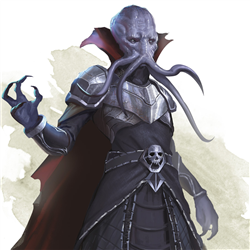 All horror draws upon our fear of the unknown, but H.P. Lovecraft's "cosmic horror" specifically draws upon horror of that which is unknowable. In the Cthulhu Mythos, Cthulhu and the other Elder Gods and their spawn are not frightening because they are giant monsters. They are terrifying because our minds can't fully comprehend what they are or what they are doing. "You cannot grasp the true form of Giygas' attack." They make us feel small and insignificant compared to their alien unknowability.
All horror draws upon our fear of the unknown, but H.P. Lovecraft's "cosmic horror" specifically draws upon horror of that which is unknowable. In the Cthulhu Mythos, Cthulhu and the other Elder Gods and their spawn are not frightening because they are giant monsters. They are terrifying because our minds can't fully comprehend what they are or what they are doing. "You cannot grasp the true form of Giygas' attack." They make us feel small and insignificant compared to their alien unknowability.
But cosmic horror is hard to pull off in Dungeons & Dragons. D&D is geared towards providing epic moments of heroic fantasy, not nihilistic scenes of grim introspection. You should play Call of Cthulhu instead if you want cosmic horror.
Monsters that are "eldritch horrors" or "eldritch abominations" are (in addition to being a very stressful board game) a way to bring the slimy, tentacled trappings of the cosmic horror genre into a pulpy, fantasy system like D&D. Eldritch horrors are scary because they're weird and disgusting, and so very different from ourselves. To play a mind flayer like an eldritch horror, you need to make the players feel that it is not just inhuman, but that it is not of this world.
A Mind Flayer’s Alien Mind
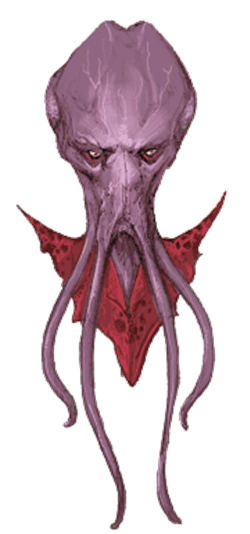 Mind flayers don’t think like people. They lack emotions. They are a hive mind controlled by an elder brain. They consider themselves superior to all beings, viewing their inferiors as little more than thralls and food. They speak telepathically, invading the minds of any creature within 120 feet of it, even if they don’t share a language.
Mind flayers don’t think like people. They lack emotions. They are a hive mind controlled by an elder brain. They consider themselves superior to all beings, viewing their inferiors as little more than thralls and food. They speak telepathically, invading the minds of any creature within 120 feet of it, even if they don’t share a language.
Volo’s Guide to Monsters features an incredibly in-depth analysis of mind flayer behavior, culture, and psychology.
Mind flayers are perfect predators. Unlike a haughty dragon or a stupid ogre, no creature can taunt a mind flayer into attacking stupidly. They have no ego to bruise, only the ruthlessly efficient mind of an elder brain. When encountering a mind flayer, there are often more nearby. Even if adventurers encounter a mind flayer separated from its kin, the elder brain and all its siblings can see as if through its eyes. You can use this alien intelligence to unsettle your players, building tension before you release it in a pulse-pounding encounter. Here are a few ways:
Telepathically lure the characters into a trap. Ominous whispers are a classic DM’s trick, but it’s even better when the whispers are guiding them through the Underdark’s twisting caverns into an ambush. Reverse psychology will do wonders.
A wet, slimy voice slithers into your mind. Even though you cannot see who is speaking, you can hear them as clearly as if they were whispering into your ear. “Follow the tunnel deeper… I know where the treasure you seek lies. Follow the water… follow the water deeper.”
Relish in the tragedy of the thralls. Tragedy is just as much a part of horror as fear and adrenaline are. These thralls were once living beings, and all of the things that made them who they were has been stripped away. They no longer think, they merely stand, shamble, and drool. One way of heightening the sense of dread in a mind flayer’s hideout is showing the players the consequences of defeat. These mindless puppet creatures that stand at eerie, motionless attention are all that remain of the illithid’s previous victims. “That could be me next.”
The dwarf takes no notice of your presence. He simply stares, glassy-eyed, into the distance. He repeats a quiet mantra in a barely perceptible whisper, endlessly. "I'll make it back to her. I'll make it back to her. I'll make it back to her." He no longer seems to know what the words even mean.
Interrupt arguments with suspense. Player characters argue. Characters in horror films argue. Player characters in horror adventures argue all the time. Horror writers have the luxury of being able to tailor the arguments to suit the plot, but often D&D players will argue in circles forever, causing the game to not only grind to a halt, but also to stop being fun. When this happens, it’s your job to intervene and move the game along. A quick Medium-difficulty combat that deals at least a little damage to all the characters will help.
Not immediately, they should be able to disagree for a moment—maybe they’ll actually come to an agreement!—but once the argument feels like it’s dragging on, nudge the player closest to you and say “Make a Perception check.” The noise of the characters bickering has attracted thralls ordered by the mind flayer to guard the passage. If any of the characters have darkvision, the creature should be just at the end of their darkvision, about 60 feet away.
If the mind flayer has quaggoth thralls, their climbing speed may have allowed them to climb onto the ceiling of the tunnel, ready to drop onto the characters.
At the far end of the passage is a figure. Human in shape, broad and hunched. It stands unmoving, as if staring at you. You can hear it breathing, faintly. Then, it shrieks. It moves faster than you would have thought, and within moments, the hulking figure is upon you, mouth open and spittle cascading from its loosely hanging jaw.
Fighting like a Mind Flayer
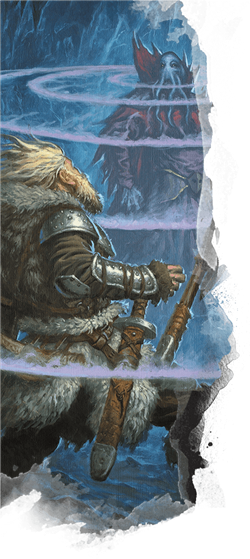 Atmosphere and building a sense of dread are excellent tools to have in a storyteller’s toolbox, but the best way to terrify D&D players is to reveal that the air of fear you’ve conjured isn’t just smoke and mirrors. Your encounter can’t just be all build-up and no payoff, it has to have teeth.
Atmosphere and building a sense of dread are excellent tools to have in a storyteller’s toolbox, but the best way to terrify D&D players is to reveal that the air of fear you’ve conjured isn’t just smoke and mirrors. Your encounter can’t just be all build-up and no payoff, it has to have teeth.
And mind flayers have plenty of teeth beneath those tentacles, but they need to be played in a way that highlights their advantages and downplays their weaknesses. If played cleverly, mind flayers make for campaign-ending bosses at lower levels. Situated at a dangerous challenge rating 7, they are the perfect opponent for a party of 5th level characters to create a fight that feels deadly but still winnable. Because of this status as low-level bosses, however, this means that mind flayers lack certain vital tools to major villains like legendary actions, lair actions, and the Legendary Resistance feature. This makes it very easy for player characters to overwhelm their already flimsy defenses.
Instead, they have an advantage that doesn’t even appear in their stat block: their thralls. Mind flayers see themselves as superior to all other forms of life, and long to dominate the inferior beings. It’s why it feels like half of the humanoids in the Monster Manual have a line in their history about how they were once enslaved by the illithids. With this in mind, let’s take a look at a mind flayer’s options in combat.
A Mind Flayer’s Traits
If you want to play a mind flayer like a terrifying and deadly alien, you need to know exactly what your options are on every turn. This will help you make purposeful choices rather than guessing at what choice is best in the heat of the moment. These options are:
Defenses. A mind flayer’s defenses are one of its weakest traits. With average armor class and abysmal hit points for its challenge rating, a mind flayer should never find itself in melee combat, and it should always try to find cover from ranged attacks if possible. Its Magic Resistance trait combined with its impressive Intelligence, Wisdom, and Charisma saving throws give it impressive magical defenses that almost make up for its lack of Legendary Resistances.
Movement. A mind flayer has an average walking speed, but it has the ability to levitate using its Innate Spellcasting (Psionics) feature, allowing it to move vertically (but not horizontally) through the air using its movement.
Innate Spellcasting. A mind flayer has a few spells (flavored as psionic powers) at its disposal. It can cast detect thoughts and levitate at will, and dominate monster and plane shift once per day each.
- Detect thoughts has no real combat utility, but can be used to before combat to learn the characters’ tactics and other secrets, depending on the needs of your campaign.
- Levitate can be used as a movement option as described above, or as a way to remove a melee fighter from the action for a time, especially if that character resisted your Mind Blast.
- Dominate monster is a powerhouse spell, letting you not just remove one of the player characters’ allies from the fight, but also giving you an ally for as long as the spell lasts.
- Plane shift is a mind flayer’s panic button. A mind flayer would much rather flee in shame than die, allowing you to plan ways to destroy those who humiliated you.
Mind Blast. This is a mind flayer’s most powerful offensive tool, giving you the power to seriously damage and potentially leave all creatures stunned within a massive 60-foot cone. Its impressive range and spreading area enables its effective use even at long range—and a mind flayer wants to be at long range as much as possible.
Tentacles and Extract Brain. In order to flay minds, a mind flayer must first do two things: incapacitate a creature and then grapple it. This is dangerous because it must enter melee range in order to do it, but if it can pick off a single target (or disastrously, stun the entire party with a Mind Blast), the incredible damage of the Extract Brain action and its potential to instantly kill a target at 0 hit points makes it a dangerous, if situational, power.
Thralls. A mind flayer’s braindead thralls can be used as a meatshield to protect a mind flayer from melee fighters. You should choose what thralls are thematically appropriate for your mind flayer villain, but a thrall is best when it is a fairly weak, melee-focused creature like a berserker or an ogre. Underdark creatures like duergar, drow, kuo-toa, and quaggoth are all excellent monsters to use as thralls.
A mind flayer can use its 120 feet of telepathy to communicate psychically with its thralls, and they obey its exact orders to the best of their ability. Because of the mind flayer’s incredible damage potential, these thralls should be a distraction that takes focus away from their master. If the characters get wise to this plan and start ignoring the thralls, they should try to grapple the characters to stop them from moving. Thralls can also protect their master from ranged attacks by getting into melee with ranged characters, imposing disadvantage on ranged attack rolls.
Encounter building is an art, not a science. Generally speaking, though, your thralls should be worth a Hard encounter on their own, ignoring the mind flayer’s portion of the XP budget. A boss fight like this should always be beyond Deadly, after all.
A Mind Flayer’s Tactics
The first rule of horror movies is that the monster is always less scary once you see it. The alien in Alien is terrifying because it’s a ruthless killing machine that is almost never on-screen. The unknown is scary. It’s a little bit different for mind flayers—they need to stay out of sight because their defenses are paper-thin—but the principle is the same. Mind flayers need to stay out of sight to remain deadly, and their deadliness is only made scarier by their elusiveness.
Your tactics may vary based on the needs of your campaign, but an effective and powerful tactical loop for a mind flayer is:
- Hide in areas of darkness or levitate at the top of a tall chamber until the characters get within 60 feet. If possible, your thralls should hide from sight as well.
- Choose a character a high-damage melee character like a rogue or a fighter and target it with dominate monster. Note that both dominate monster and levitate require concentration, so don’t try and use this spell while levitating. If the character fails its save, command it to attack the cleric or low-defense characters like a wizard.
- Your thralls come out of hiding, attacking the characters while the dominated character continues to cause chaos.
- Once the dominated character is freed, use your Mind Blast to hit as much of the party as possible, while still remaining hidden.
- Only come out of hiding to use your Tentacle and Extract Brain actions on a stunned character. Note that since you have a +4 bonus to Stealth, it’s reasonable for a character who succeeds on a DC 14 Wisdom (Perception) check to see you in your hiding spot.
- Use your Mind Blast whenever it recharges and stay out of melee range. Have your thralls grapple stunned characters and drag them away from the party to make it easier to eat their brains without being attacked.
- If you are reduced to 1/4 of your maximum hit points, sneer at the characters and use plane shift to flee combat. Killing characters and then fleeing before you can be killed is a surefire way to make the party hate you.
As a general tip, even if the entire party was stunned by your Mind Blast, don’t get greedy and close in for the kill yet. Any character could succeed on a saving throw at the end of their next turn, leaving you in a very dangerous position.
Having Fun Playing a Mind Flayer
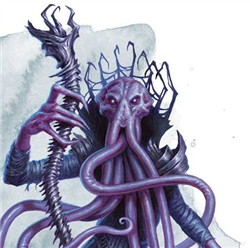 Like I described in How to Play a Red Dragon like an Evil Genius, the best way to give you and your players a fun and engaging encounter is to get into the head of the creature you’re using. This is especially hard when playing a mind flayer for a couple of reasons, not least of which is its alien mind. Its main selling point is that the players can’t get into its head, so how should you be expected to do it?
Like I described in How to Play a Red Dragon like an Evil Genius, the best way to give you and your players a fun and engaging encounter is to get into the head of the creature you’re using. This is especially hard when playing a mind flayer for a couple of reasons, not least of which is its alien mind. Its main selling point is that the players can’t get into its head, so how should you be expected to do it?
I think of it as playing a human sociopath that has their whole sociopath family on speed dial. They’re selfish, cruel, and still somehow perversely charismatic. Other people follow this creep mindlessly, obeying their every order and not listening to anything anyone else says. I’m sure you’ve met someone like this in real life. Now just imagine if this person had psychic powers and could eat your brain.
This is just the beginning of what a mind flayer can do. As you explore the depths of the illithids’ horror in your game, consider how a psionic variant mind flayer would use its psionic powers. How would an alhoon (a mind flayer lich) use its deviant arcane magic? How would a mighty ulitharid use its potent psionic powers to command other creatures?
It’s best to ponder these questions while sucking on a freshly picked brain.
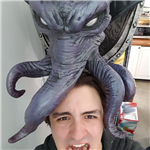 James Haeck is the lead writer for D&D Beyond, the co-author of the Critical Role Tal'Dorei Campaign Setting, and writes as a freelancer for Wizards of the Coast, the D&D Adventurers League, and Kobold Press. He loves mind flayers so much, his first ever published D&D adventure features a mind flayer as the big bad. He lives in Seattle, Washington with his intellect devourers, Mei and Marzipan. You can usually find him wasting time on Twitter at @jamesjhaeck.
James Haeck is the lead writer for D&D Beyond, the co-author of the Critical Role Tal'Dorei Campaign Setting, and writes as a freelancer for Wizards of the Coast, the D&D Adventurers League, and Kobold Press. He loves mind flayers so much, his first ever published D&D adventure features a mind flayer as the big bad. He lives in Seattle, Washington with his intellect devourers, Mei and Marzipan. You can usually find him wasting time on Twitter at @jamesjhaeck.








-
View User Profile
-
Send Message
Posted Mar 14, 2018I feel that my villains feel more villanous if they do have an ego. Then again, no emotions is scarier.
-
View User Profile
-
Send Message
Posted Mar 14, 2018One of D&D's most iconic villains given a much-needed makeover. Just what the (lawful evil) doctor ordered!
-
View User Profile
-
Send Message
Posted Mar 14, 2018Some of the broader points here apply really well to playing highly intelligent (but otherwise weak) opponents in general!
-
View User Profile
-
Send Message
Posted Mar 14, 2018I like this article, especially the structure. You outlined how it could go bad in the beginning and seeded solutions throughout. This is very well thought out.
-
View User Profile
-
Send Message
Posted Mar 14, 2018Hee hee, man mindflayers remind me of a nightmare I had as a preteen. Never read H.P. Lovecraft, nor had to play against one.
Weirdly it was like a rebel world war II theme to it. Riding in an open VW wagon (can't remember the name of the vehicle). Looking down a hill, hiden behind a large propaganda billboard. A number of other ?people? Were routinely taking apart and resembling small caliber rifles. I believe we been doing such thing till it was motor memory.
We were to enter a bright white Church that we believed to have the leadership of enemy force's staying at.
Nothing stopped us from getting to nor entering the church. Then the madness began. There was four priests talking to each other. As my group entered and felt a calmness sweep through us. The priests faces started to shiver, as three tentacles grew from below they're missing noses..
Man... To this day it still freaks me out, that I wasn't able to move, and all that motor memory training failed..
-
View User Profile
-
Send Message
Posted Mar 14, 2018James Haeck, I'm in love with you, I've decided. I've got a paladin who's willing to give a pretty cool buff, if you're up for it.
-
View User Profile
-
Send Message
Posted Mar 14, 2018Awesome... love these tips as a fairly new dm having these tips makes a great additionally resource to have
-
View User Profile
-
Send Message
Posted Mar 14, 2018These are so helpful. Thank you for them.
-
View User Profile
-
Send Message
Posted Mar 15, 2018Great write-up on a great creature. Giving me a little more to play with in a couple of my Mind Flayer adventure hooks sitting in the back of my brain ... hopefully nobody will suck it out of my there!
-
View User Profile
-
Send Message
Posted Mar 15, 2018I love this! I'm working on an eldritch horror/lovecraftian homebrew right now and this is some good inspiration for me.
-
View User Profile
-
Send Message
Posted Mar 15, 2018I love these tactic type articles in general - because rolling a low initiative and the PCs stabbing the mind flayers would be something that would happen in my game.
-
View User Profile
-
Send Message
Posted Mar 16, 2018I agree that using the tragedy of the thralls to instill a sense of dread works wonderoisly. When I had my PCs encounter a (mostly) abandoned mind flayer colony, they were a bit freaked out by me describing partially dissected corpses and various creatures floating in briny liquids (as of from sick science experiments) dotting the various chambers.
Another bit that worked wonders was using clicking noises when Grimlocks were around. I tried to figure how they would navigate being blind in tunnels and figured a form of echolocation would fit well. It created moments of panic as these thralls tore through the tunnels “looking” for the party.
My favorite moment of the entire sidequest was when the PCs all got ambush/cornered by Grimlocks in the dark (so, my description of them was vague). The PCs decided to freeze and stay silent and I had the Grimlocks “look” around, clicking methodically, and slowly moving forward. The Grimlocks were searching for a change in the environment to indicate movement. But one of the players (out of character) finally had a lightbulb moment and yelled “oh my god, they’re BLIND”. It was a tense, but very fun couple of sessions.
-
View User Profile
-
Send Message
Posted Mar 16, 2018Its a combination of Davy Jones and Cthulhu.
-
View User Profile
-
Send Message
Posted Mar 16, 2018Great article, James. I particularly like the idea of thralls binding up and carrying off stunned heroes in the middle of combat. One variant I've had fun with and would recommend for DMs is the Mindflayer Arcanist in the MM. Mindblasting and casting high-level sleep (remember, no save) spells from behind a wall of force with impunity can demoralize a party. Or try tweaking the spell list to add meld to stone and misty step, combined with invisibility and clairvoyance, for a mindflayer that ambushes the heroes with mind blast and disappears, only to assault them from behind or above a few rounds later. And perhaps use disguise self to pretend to be a slave and lure in and pick off the last few remaining PCs as the try to rescue him.
-
View User Profile
-
Send Message
Posted Mar 16, 2018Great article, James. I particularly like the idea of thralls binding up and carrying off stunned heroes in the middle of combat. One variant I've had fun with and would recommend for DMs is the Mindflayer Arcanist in the MM. Mindblasting and casting high-level sleep (remember, no save) spells from behind a wall of force with impunity can demoralize a party. Or try tweaking the spell list to add meld to stone and misty step, combined with invisibility and clairvoyance, for a mindflayer that ambushes the heroes with mind blast and disappears, only to assault them from behind or above a few rounds later. And perhaps use disguise self to pretend to be a slave and lure in and pick off the last few remaining PCs as the try to rescue him.
Excellent ideas! I wish I'd had more space in this article to give some options for spellcasting mind flayers, like I did with the red dragon article. I hope people see your comment and think about the spells their mind flayers can use to devastate the PCs!
-
View User Profile
-
Send Message
Posted Mar 22, 2018I like this very much. I'm also a huge Illithid lover, since I'm really into cephalopods xD
Basically, having your villain use indirect measures to get rid of characters is preferable to risking life and limb. I feel that a creature of alien intellect and composure probably does a lot better than charging at enemies. Be sneaky, manipulative, play heroes against each other, possibly reading their minds and baring secrets, all while staying safely out of reach of them. Maybe the characters are in a tight canyon, and the illithid is on a sort of gallery, able to easily hide behind cover and get into their heads.
Love them. I'm really happy with my signed limited edition of Volo's Guide to be quite honest.
-
View User Profile
-
Send Message
Posted Sep 16, 2018Great article! I was just planning on sending my party at Mind Flayer colony. This gave me several ideas. Thanks for your work!
-
View User Profile
-
Send Message
Posted Feb 3, 2019No offense. Mind flayers seem pretty weak man. I mean yeah mind blast is pretty rough. How do they enthrall things anyway? Fear of more mind blasts and staying off the brain menu? There's no indication what ability allows this - why not charm or geas as a normal action once per day - even those don't give you a mob of mind controlled suckers ... idk the stats don't explain the flavor and therefore the appeal is lost.
I had an idea to create an up and coming mind flayer archanist early in the campaign. It's newly apostate from its conclave as the flavor text suggests at this stage of its villian career. The party would stumble across as he's maybe establishing his first lair in their first dungeon and its just now hatching some scheme against the heroes beloved hometown, vacilitating a fight, escape scene and promise of future encounters where I can add spells, hp, etc ... the villian growing in ability over several encounters. However, a dumbed down mind flayer with no minions and a couple of cantrips would be a cake walk for any party and this Artemis Entreri like villian arc I wanted to try to produce would be over before it started. It'd come down to winning round 1 initiative, not a very hair raising villian ... whereas they have that Cthuluish, alien, straight out of a nightmare sort of flavor you want in an archvillian. Hmmm ... if anyone is aware of a homebrew solution that sort of addresses what I'm saying I'd love to hear it. Thanks!
-
View User Profile
-
Send Message
Posted Apr 24, 2019I have one of these as an upcoming bad guy for a level 5 group and I really appreciate this. Well written!
-
View User Profile
-
Send Message
Posted Nov 1, 2019Always great articles. And I even bought that illithid module you pimped.